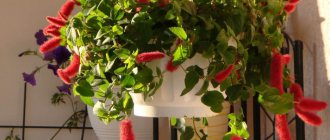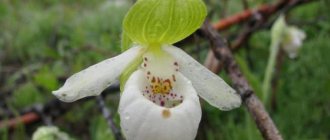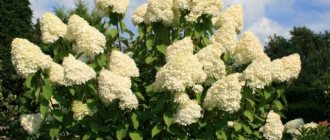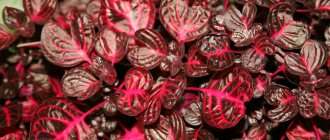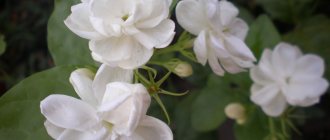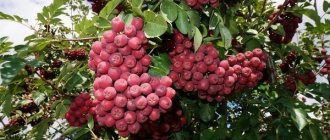Description of the appearance of the plant
Arrowroot is a plant that belongs to the Maranthaceae family. The rhizome is represented by tubers. On the stem there are green leaf plates up to 14 cm long in 2 rows. They usually have an oval shape and patterns of various shades. At night, the leaves straighten, and then the plant stretches 35 cm in height.
A longitudinal vein with red-violet rays runs through the center of the leaf.
The inflorescences are shaped like a spike, which ends in an asymmetrical flower. The color of the small buds has shades of white or light purple. The fruit of the arrowroot is a single-seeded capsule.
Common varieties
The genus Maranta includes about 40 species. The most popular varieties include:
- Tricolor;
- Two-color;
- Massanja;
- Kerkhoveana.
Medicinal properties
The rhizomes of Maranta arundinacea are of practical importance and are used in cooking and medicine. They are ground into flour and used for weight loss, adding to baked goods and other dishes. The beneficial properties of the plant allow you to remove waste and toxins from the body.
Doctors advise people suffering from gastrointestinal diseases to include flour from the rhizome of the plant in their diet. It has a warming effect and is rich in carbohydrates and microcomponents.
Note! Before use, consultation with a specialist is required.
Briefly about the history of appearance
The tropical part of America is considered the birthplace of the perennial. W. Houston once brought seeds from Brazil to Europe. The name of the herbaceous plant was given in honor of the botanist and doctor who lived during the Middle Ages - Bartolomeo Maranta.
The second name for tricolor arrowroot - “fascinator” or “prayer flower” - appeared due to the peculiarities of the plant’s appearance. During bad weather, arrowroot folds its leaves in such a way that they look like the hands of a praying person.
Types of arrowroot with photos and names
White-veined arrowroot (Maranta leuconeura)
Under natural conditions, the plant can be found in the tropics, or more precisely, in the rainforests of Brazil. It has a tuberous root, and the length of the stem can reach about 0.3 m. The petioles of the foliage reach no more than 20 mm in length. The width of the leaf plate is about 9 centimeters, and the length is up to 15 centimeters; they have a rounded-elliptical shape, while at the base it is heart-shaped. Their front surface is dark green, it is decorated with a pale green pattern and white veins, the back surface is greenish-blue or pale red. The most popular varieties of this species among gardeners are: Kerchoveana, Masangeana, tricolor or red-veined (leuconeura):
Maranta kerchoveana
The height of such a herbaceous perennial plant is about 25 centimeters. The short-petioled oval leaf blades are about 15 centimeters long. The upper, rich green surface of the plate has many dark green spots, and a white stripe runs along the midrib. The reverse surface of the plate has a color that can change from light blue to pale red. White flowers are collected in 2-3 inflorescences.
Maranta massangeana
The plant is very similar to the Kerkhoven variety (see above), but its foliage is decorated with brownish-olive spots.
Maranta tricolor (Maranta tricolor)
The length of the oval pubescent leaf plates is about 13 centimeters, and the width is up to 6 centimeters. The color of the front surface of the plates can vary from dark green to a greenish tint; it is decorated with red veins and pale green spots along the midrib, and dark green feather-shaped spots are located along the lateral veins. The reverse surface is crimson with pink streaks. The flowers are colored pale lilac.
Maranta bicolor
This species does not form tubers. The oval, short-petioled leaf blades have a slightly wavy edge and are about 15 centimeters long. On the front surface of the green plate along the midrib there are brown spots, and on the back there are hairs, and it is colored pale red.
Reed arrowroot (Maranta arundinacea)
This species is represented by a shrub whose height slightly exceeds 100 cm. Its roots are thick and tuberous. The length of the ovoid leaf plates is about 25 centimeters, they have a slight point at the top. The underside is covered with hairs and has a dark green color. The flowers are white.
Arrowroot is an unpretentious home flower. My flowers. My experience.
Features of plant care at home
Maranta - home care and propagation
Arrowroot fascinator tricolor is not demanding in care. If you follow simple and understandable rules, you will be able to see a healthy plant with beautiful leaves on your windowsill. In spring and summer, pots of flowers are taken out onto the street or balcony.
As a container, choose a hanging or tabletop ceramic or plastic pot
It is important to take care of the location of the pot with the prayer flower. The most unfavorable room is the kitchen. Maranta has a bad attitude towards natural gas combustion products.
Note! Under no circumstances should the plant be exposed to drafts.
To remove dust from the sheet plates, use a damp cloth. Use it to gently wipe the surface without pressing on the sheet.
Temperature
The optimal summer temperature for arrowroot is approximately 19-24 ℃ above zero. In winter, the readings on the thermometer should not fall below +15 ℃. Sudden temperature changes are undesirable for indoor perennials.
Note! You should not place a pot with a prayer flower near an open window.
Lighting
The plant does not need a lot of light. Lighting for it should be moderate. It is recommended to place the arrowroot on a shelf close to the western or eastern window of the apartment.
Watering
You need to water the prayer flower about 2-3 times a week. An abundance of moisture can negatively affect the root system of a perennial.
Spraying
Since the plant’s natural habitat is areas near swamps and water basins, it is important to maintain a moisture balance. To do this, every day you need to spray the flower with a spray bottle with soft water.
Humidity
Under normal conditions, humidity should be 60%. During periods of particularly hot weather conditions, it is required that the humidity rise to 80%.
Priming
The soil for a prayer flower should contain peat and sand. You can prepare such soil yourself or purchase it ready-made at a flower shop. The soil should not be heavy, it is important that air can penetrate inside.
Feeding
Mineral supplements are necessary during the growing season. It is recommended to apply fertilizer in the form of liquid mixtures twice a week.
In flower shops you can easily buy fertilizers for arrowroot
Features of care in winter, rest period
Caring for tricolor arrowroot at home in winter is practically no different from caring for it in other seasons. The dormant period of the flower lasts from October to February. At this time, the number of waterings is reduced to once a week. In addition, the pot is moved to a cooler place.
Important! Do not allow direct sunlight to hit the surface of the leaves. Otherwise, the leaves will become covered with burns in the form of spots.
What care does arrowroot tricolor require at home?
Hello, dear readers!
Among houseplants, there are those that are valued not for their flowers, but for their leaves. Tricolor arrowroot can easily be classified as one of these. Arrowroot is a perennial herbaceous ornamental plant with very beautiful leaves. They are bright green in color, and on the upper side of each there are light veins, spots or stripes.
As for flowers, they do not shine with special beauty in any variety. The flowers are produced periodically on long thin stalks and may have white, light pink or yellow petals.
Perhaps the most beautiful is the tricolor arrowroot.
When and how does it bloom
Dieffenbachia flower - home care
The plant blooms with small flowers that can be colored in light shades of purple and white.
Types and forms of flowers
The arrowroot bud has an elongated shape. The flowers of the plant are small, reaching 2-3 cm in length.
Flowering period
It is not always possible to see flowering at home. The period falls in the middle of the summer season.
The average flowering time is 2 months
Watering and spraying
Arrowroot requires abundant and regular watering to prevent excessive drying of the soil.
However, excess moisture in the substrate can be detrimental to the plant, as it leads to rotting of the root collar. Usually in summer watering is carried out every other day , and in winter - 1-2 times a week. For this procedure, use only rain, snow, boiled or settled tap water.
A reliable indicator of the need for regular watering is drying the surface layer of soil to a depth of 2 cm .
Spraying also has a beneficial effect on the plant, especially in summer.
How does arrowroot tricolor propagate?
Arrowroot propagates by dividing the bush or by cuttings. The second method involves the use of short shoots.
Germination of seeds
In early spring, flower growers sow arrowroot seeds. The seeds are distributed into a box with soil, sprinkled with peat. It is best to then cover the container with film and leave for 10 days, occasionally ventilating. After this time, the first shoots will appear and can be distributed among the pots.
Rooting cuttings
The best way to propagate a prayer flower is cuttings. Elongated shoots are cut with a knife, lowered into water and wait for roots to begin to form. The water should be settled and at room temperature. As soon as the root system appears, the cuttings are transplanted into the ground and covered with polyethylene to create a greenhouse effect.
Note! The process of formation of the outer stalk takes 90 days. Do not remove the film from the plant ahead of time.
Dividing the bush
When planting a plant in the spring, transplant part of the bush. The flower is removed from the container and divided in half, separating the roots with a sharp tool. Each of the two fragments is planted separately in different pots, watered and covered with film.
The root system is very fragile and small, so it is important not to damage it
Arrowroot propagation
The best way to get a new plant is to propagate arrowroot by dividing the bush at the right time for replanting. The separated parts of the plant are planted in small pots with soil composed as described above.
To root the separated parts of the plant, the pots are covered with film and kept in a warm place. It is advisable that during this period the air temperature should not be lower than +20 degrees. When the plants take root and begin to grow, the film can be removed and further cared for, as stated above. Usually, if these conditions are met, the rooting of arrowroot occurs without problems.
Arrowroot can also be propagated by apical cuttings. To do this, in late spring or summer, you need to cut cuttings with 2-3 leaves from new shoots of the plant and place them in water. Arrowroot cuttings take root in about five to six weeks. They take root well in greenhouses with elevated temperatures and humidity. The cuttings that have taken root are planted in a peat-based planting substrate.
Reed arrowroot, also true arrowroot, or West Indian arrowroot (Maranta arundinacea). © Nobis85
Transfer
Young plants, from 1 to 3 years old, need to be replanted annually. The optimal time is spring. The new pot should be slightly larger than the previous one in size. It is best to take a container with a diameter larger than 4 cm. The flower must be taken out along with the soil, its root system inspected for signs of rotting and any existing defects must be trimmed. Drainage is installed at the bottom of the new pot to prevent water from stagnating. The plant is transferred to a container, covered with soil and watered abundantly.
On a note! Stronger plants are replanted approximately once every 2-3 years.
Landing
If arrowroot is grown separately, then the pot for the perennial should be selected in a small size. Rooting with other tropical crops will require placing the plants in wide but shallow containers. A composition of several tropical bulbous crops should be rooted while maintaining the distance between them for the free development of the root system. The bulbs should not contact each other.
The roots of arrowroot do not grow deep into the soil, but require space for further development.
When planting in containers or pots, care should be taken to ensure there is drainage at the bottom. For these purposes, you can use small fraction pebbles, expanded clay or crushed stone. As for the composition of the soil, for tropical perennials it is recommended to use light soil with good aeration and weak acidity. The substrate can be purchased at the store; for tricolor arrowroot, universal soil is suitable. The gardener can also prepare it himself.
The soil mixture will consist of the following components:
- humus - 2 parts;
- torus – 1 part;
- coniferous bark - 1 part.
As a useful addition, you can also include moss or charcoal. The last component can be replaced with calcined river sand.
Possible problems in cultivation and diseases
The main sign in monitoring the correct care of the plant is the appearance of the leaves. If they are symmetrical, even plates without spots or defects, then the flower feels comfortable.
Drops buds and leaves
The falling of leaves and buds is caused by a decrease in temperature or increased moisture content in the air.
The leaves are turning pale
The paleness of the leaves is caused by the rays of the sun. If the plant is exposed to direct ultraviolet rays, the plates become covered with pale burns. The tricolor perennial should not be allowed to grow in the sun for a long time.
The tips of the leaves are drying out
The ends of the leaves may dry out and change color. Usually the plant reacts in this way to low humidity, hot air or the appearance of pests. It is necessary to change the conditions and inspect the flower for the presence of parasites.
Pests
Parasites that interfere with the active growth and development of the plant are aphids, scale insects and spider mites. Flower shops produce preparations for treatment.
Other problems
The shoots of the plant may begin to become very elongated, and the leaves may become smaller. Usually the problem is a lack of light. The plant needs to be moved closer to the source to normalize its condition.
Leaves may curl up due to lack of moisture.
Arrowroot diseases
If you see that the arrowroot leaves are turning yellow, their ends are brown and dry, and the plant’s growth is slow, then most likely your flower does not have enough moisture and the air around the plant is too dry. It is necessary to increase the air humidity, spray the arrowroot more often, place the pot in damp peat or on pebbles with water in the pan.
Too dry air can lead to arrowroot leaves curling and falling off, as well as spider mite damage to the plant. Spider mites are very small red spiders. Appears on the underside of leaves and envelops them in thin white cobwebs. It is destroyed by spraying and washing the leaves, especially on the underside, with water, weak tobacco infusion with soap, pollination (in the fresh air, outside rooms) with ground sulfur, or the plant is treated with ready-made systemic insecticides.
When treating arrowroot leaves with infusions, after 2-3 hours the leaves should be washed with cool water. Treatment of the plant will have to be repeated several times until the pests are completely destroyed. To avoid damage by spider mites, the plant must be kept clean, frequently sprayed, and kept away from central heating radiators.
If the plant is kept cold and watered too hard, then diseases are inevitable for arrowroot. In this case, the flower’s stems and leaves will wither and rot; if the conditions of maintenance are not changed, the arrowroot will die.
Maranta (Maranta subterranea). © Alex Popovkin
Arrowroots are demanding in terms of light conditions. If the light is too bright, the leaves lose color. If direct sunlight hits the leaves, they may burn. Arrowroots need diffused light. The arrowroot flower must be shaded from direct sunlight.
Do you have arrowroot growing in your house? Share your experience of growing it in the comments to the article or on our Forum.
Signs and superstitions
Some people believe that the plant carries positive energy, so placing pots in crowded places will help get rid of negative energy and bring order to the atmosphere. According to signs, arrowroot attracts good luck and protects people from the evil eye.
Interesting information! According to popular opinion, placing a flower pot by the bed allows the sleeper to calm down, get enough sleep and become more productive.
Arrowroot tricolor is an elegant evergreen plant that can live at home for up to several years. If you take care of the flower in a timely manner and pay attention to it, it will always delight you with its attractive appearance.
Landing
a shallow but wide ceramic or plastic pot is best This is explained by the fact that arrowroot roots do not penetrate deep into the soil, but form additional underground tubers that require sufficient free space for their development.
To grow healthy and beautiful indoor plants, it is worth preparing a balanced, breathable substrate that has a slightly acidic reaction environment.
For the latter, either ready-made store-bought formulations or self-prepared mixtures are used. The following option has worked well:
- 2 parts peat;
- 1 part coarse river sand;
- 2 parts leaf humus.
This universal mixture also deserves special mention:
- 2 parts peat;
- 4 parts leaf humus;
- 1 part rotted manure;
- 1 part river sand.
To make the substrate more loose, you can add pine bark, sphagnum, crushed charcoal or coniferous soil . Additionally, drainage is arranged by pouring expanded clay, broken brick or small crushed stone into the bottom of the flower pot in a layer of up to 5 cm.
The video shows the main points of flower care:
Indoor air humidity
Like any native of the tropics, arrowroot prefers conditions similar to the climatic features of its natural habitat. The air humidity is no exception, which should be as high as you can achieve. Throughout the year, arrowroot must be sprayed daily with soft water. In winter, when heating systems are operating in the rooms, it is recommended to spray arrowroot twice a day - in the morning and in the evening.
This may be interesting: Description and photos of popular Philodendron species
In summer, it is advisable to give the plant a warm shower, but the pot should be covered with film to prevent water from getting into the soil. To further increase humidity, place the flower pot on a tray with wet expanded clay or pebbles. Make sure that the roots do not come into contact with moisture, as it will cool and prevent the soil from drying out, and, as we said earlier, arrowroot does not tolerate low temperatures and swamps in the ground.


